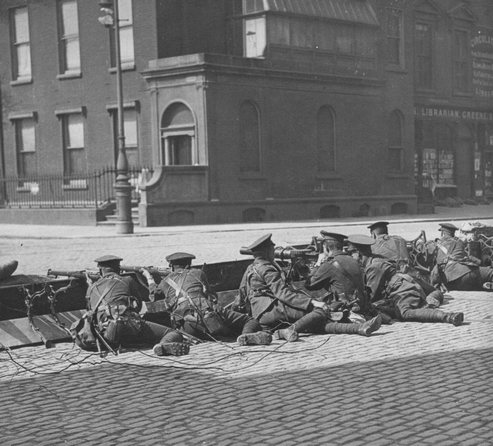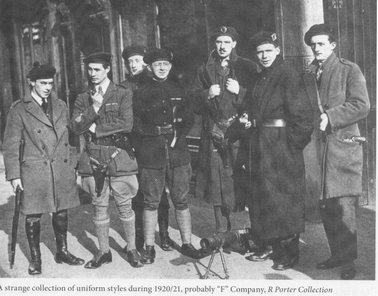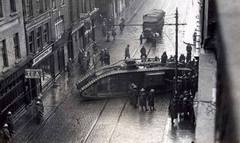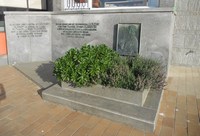The Dragon’s Voice
Hello. In this edition, we have an article by Keith on nursing in WWI and a postscript from Caroline about Kut. As ever, many thanks to Jim Morris for allowing us to use his WWI day by day material on the Facebook page.
Trevor
The Programme for 2016
June 4th - Lionel Rees VC - Alistair Williams
July 2nd - General Sir Horace Smith-Dorrien - Arthur Aston
August 6th - Lesser Known Heroes of WW1 - Andy Johnson
September 3rd - Profiles of the Great War, Silhouettes of Captain Oakley - Jerry Rendell
October 1st - Lord Ninian, 6th Welch and the Battle of Loos (Two weeks in the life of a Welsh Battalion on the Western Front) - Marietta Crichton-Stuart
November 5th - Mountaineers in the Great War - Anne Pedley
December 3rd - Branch Social
Last month’s speaker (May)
 Trevor presented a talk on the Easter Rising 1916 written by Denis McCarthy and him. Unfortunately, Denis could not attend due to an urgent work commitment, but he was present in spirit.
Trevor presented a talk on the Easter Rising 1916 written by Denis McCarthy and him. Unfortunately, Denis could not attend due to an urgent work commitment, but he was present in spirit.
A key theme of the talk was to debunk myths and propaganda surrounding the period, both in the lead up to the Rising and its long aftermath. In particular, the myth of the period being the English versus the Irish was, hopefully, put to one side, not least as there were many English people (often referred to as Anglo-Irish) on the side of the rebels, and on the other hand the British troops, especially for the first two days of the Rising, were almost all were from Irish regiments, notably the Royal Dublin Fusiliers. Indeed, Caroline has a cousin who was a 2nd Lt. in the Inniskillens who was killed on the
Photo: Molly Childers and Hon Ellen Spring-Rice gun-running on board the "Askard" April 1914
Friday of the Rising, mistakenly by an RDF sentry, and is buried in Derry city. The role of the 1912-1914 Ulster crisis as a cause of the Rising was explained (and indeed as a reason for the British government having its eye “off the ball” in the July 1914 crisis in Europe).
The switch in public opinion from reviling the rebels to sympathy with them was explained in the light of the repression after the Rising and the treatment of the rebels, including the execution of the 14 in Dublin (plus Thomas Kent in Cork and the subsequent execution of Roger Casement in London). Indeed, we are now coming up to the centenary of the Irish internees being sent to Frongoch camp near Bala, 11th June.
Following on from that period, the bitter War of Independence era (1919 to 1921) was looked at, culminating in July 1921 in the truce, and ultimately the signing in December 1921 of the Treaty setting up the Irish Free State.
There then followed the civil war, between the new Irish government and the Irish diehards who would not accept the Treaty, and which petered out in April 1923.
It is perhaps worth mentioning that the number of official British executions of prisoners in
the two and half years of War of Independence was 24, whilst the new Irish government executed 77 prisoners, officially, in the ten months of the civil war.
The talk finished with a postscript on some of the key characters and what happened to them, perhaps the most bizarre being General Lowe’s son John. After the end of WWI, he went to Hollywood and became an actor under the name of John Loder, married Hedy Lamarr and starred in “How Green is my Valley” with Roddy McDowall!
Perhaps the best postscript for the whole period was one in an internet article on the civil war:
The Irish revolution, born out of violence, but also with great hopes, in 1916,
died a miserable death in the back-roads of Kerry in the spring of 1923


Photos: top right, British troops in the Easter Rising 1916; above left, Auxiliaries "Auxies", War of Independence Dublin 1921: above, tank in Dublin, War of Independence Dublin, 1921
Ambulance de L‘Ocean, De Panne
Keith Walker
On the sea front at De Panne in Belgium, there are two interesting plaques on the wall of a modern hotel.
The first is to the Queen Elizabeth of Belgium (b 25th July 1876 - d 23rd November 1965):

The second to Dr Antoine Depage (b 23rd November 1862- d 10th June 1925):
There is a close connection between these two people going back a number of years.
In 1907, Dr A Depage opened at 143-149 de la Culture, Brussels, the first training school for nurses. The school was situated in four terraced houses across the street from the Berkendael Surgical Institute where Dr A Depage was a leading surgeon. Dr A Depage was impressed by the English model of secular trained nurses. He wanted to work with such nurses. He was an innovator and reformer. He needed an English Matron to run his pioneering school. So, he appointed Edith Cavell (b 4th December 1865- d 12th October 1915). Dr A Depage had the support of the royal family in setting up the school. Over the following years the school expanded. It took over another three buildings in Brussels. Queen Elizabeth herself would sometimes help in the nursing.
Edith Cavell with Antoine Depage and nurses at Brussels, 1907
In 1914, when the war started, the Queen offered the Royal Palace in Brussels as a Red Cross hospital. When it became too dangerous for the royal family to remain in Brussels, they moved to Antwerp and when that city fell, the royal family moved to De Panne on the Belgian coast. It was at De Panne where the Queen asked Dr A Depage to set up a field hospital. She obtained the Hotel Ocean from the brewing Family Huysseune in 1914.
Dr Depage's military hospital, the Ambulance de L’Ocean, was set up near the front line. Dr Depage
believed in getting the casualties to the hospital as quickly as possible. The hospital started with two hundred beds. By 1916 it had nine hundred, and at the end of the war in 1918 it had over two thousand. The hospital took over all the surrounding buildings. It was set up with a triage system, so it had separate wings, and segregated the casualties according to their needs.
The hospital also had a laboratory to analyse infected and injured tissue. One man who assisted with this was Alexander Fleming (b 6th August 1881 - d 11th March 1955). Fleming was a Captain in the RAMC and was mentioned in dispatches. He worked in many hospitals on the Western Front.
Another notable visitor was Marie Curie (b 7th November 1867 - d 4th July 1934) and her daughter Irene (b 12th September 1897- d 17th March 1956) with their “petites curies”. These were their mobile radiological units. Marie set up twenty mobile units, and two hundred radiological units in field hospitals all over the Western Front.
Dr Depage's wife Marie (b 23rd September 1872 - d 7th May 1915) was a trained nurse. She worked as a nurse in the Royal Palace hospital in 1914, and she was active with Edith Cavell in the resistant movement. Late in 1914, she moved with her husband to De Panne to help convert the Hotel Ocean into a hospital. In January1915, she went to the U.S.A. to raise funds for the hospital. She raised $100,000 and $50,000 worth of supplies. In April 1915, she booked a return passage on the RMS Lusitania leaving New York on the 1st May 1915. The ship was sunk by the U20 submarine on the 7th May 1915. Marie was drowned, but her body was recovered and returned to Belgium. Dr Depage arranged for her to be buried in the sand dunes in front of the Ocean hospital. The funeral was attended by the King and Queen.

Left: Marie Depage’s funeral
Queen Elizabeth of the Belgians played an important role in the First World War. She was instrumental in obtaining the Ocean Hotel. When it opened she was a frequent visitor to the hospital. The Royal family had a villa at the other end of the sea front in De Panne. She was never in the hospital full time as a nurse. There is a myth of the “Queen Nurse” but she would on occasions help in the bandaging of wounded soldiers. Her main role was as a morale booster. The Queen was very active in fundraising for the hospital. It is no wonder that the hospital is sometimes referred to as “The Queens Hospital”.
 Queen Elizabeth at the hospital
Queen Elizabeth at the hospital
By the end of the war the hospital had treated over twenty four thousand casualties. It was the largest Belgian front line hospital. It expanded to forty six buildings
Expansion of the hospital
During World War Two, the Hotel Ocean was again used as a hospital. The building was demolished in 1961. Most of the Belgium burials from the hospital are at the De Panne Communal Cemetery - three thousand seven hundred and forty eight. In the cemetery, there are two British WW1 burials, and two hundred and fifty nine WW2 casualties.

This statue is situated in the gardens of the Hotel Ariane in Ypres
Bringing the casualties to the hospital was the Munro Flying Ambulance Corps, who were all volunteers, headed by Dr Hector Munro. Part of his team were Elsie Knocker MM (b 29th July 1884-d 26th April1978) and Mairi Chisholm MM (b 26th February1896 - d 22nd August 1981). Their story is told by Diane Atkinson in the Book “Elsie & Mairi go to war” published by Arrow books in 2009. There is a new statue to Elsie & Mairi.
Another member of Dr Munro's team was Lady Dorothie Fielding MM (b 6th October1889 - d 24th October 1935). Lady Dorothie was the first woman to be awarded the Military Medal. It was gazetted on the 1st September1916.
Under the King Albert 1 Memorial in Nieuwpoort there is a new museum. The main exhibition is about the flooding of this area. Also shown as part of the Battle of Nieuwpoort and the Ysar is the work of Dorothie Fielding. The King Albert 1st Memorial and the British Memorial to the Missing have just been refurbished. The memorial and the museum are well worth a visit.
In Brussels there is a memorial to Edith Cavell and Marie Depage (photo below). It is interesting to note that Matron Edith Cavell and nurse Marie Depage were both active in the resistance movement. Dame Stella Remington the former Director General of MI5 has found evidence in the military archives in Belgium of this activity. They would write details of German trench systems and locations of munition dumps on strips of fabric, and these would be sewn into clothes, or hidden in shoes or boots of the escaping soldiers. It is now known that RMS Lusitania was carrying ammunition. Maybe the Germans had a point, as Edith Cavell and Marie Depage were warned by the Germans.

The inscription reads: “Passant, dis-le a tes enfants ils les ont tuees”, translated as “Passer-by, tell your children, they killed us"
There is a myth that when Marie Depage was exhumed from the sand dunes at De Panne and that the site of her new grave was lost. In fact, she was reburied in 1925 with her husband in Brussels.
Sepultur d'Antoine et Marie Depage at Wattermael-Boitsford
King Albert 1st, Queen Elizabeth, Dr A Depage, Marie Depage, Edith Cavell, Elsie Knocker, Mairi Chisholm and Dorothie Feilding are revered as national heroes by the Belgians.
The coast from Nieuwpoort to Dunkirk and from Nieuwpoort to Dixmunde is an area neglected by us when we look at the Western Front. The twenty miles of the front line the Belgians held for the four years hardly moved.
References and acknowledgements
CWGC
De Panne tourist office
West Front Museum, Nieuwpoort www.nieuwpoort.be
The Surrender of Kut: What Happened Next
Caroline Adams
On 29th April, 1916, the Ottoman troops entered Kut. The civilian population of Kut were the first to suffer. Anyone suspected of co-operating with the British were summarily executed, mainly by being shot or hanged on tripod gallows where they slowly strangled. By the time the British troops were marched out of the city four days later, one officer reckoned that half the civilian population had been killed, many corpses being left hanging. The Sheik of Kut-al-Amara and his sons were included in those killed.
For the Ottomans, the capture of Major General Townshend was a major propaganda coup. His men may have looked more like a bunch of scarecrows than a noble defeated foe, but at least their Major General could be feted and shown off as a prize exhibit and he was kept in relative luxury for the rest of the war.
There were 13,309 men of the 6th (Poona) Division and its attached units who became prisoners of the Ottoman Empire. About 1,100 sick and wounded were exchanged for Ottoman PoW casualties. The rest set off for Baghdad. Officers and the rest of the wounded went by boat (many on the Julnar which had been captured in its attempt to resupply the city during the siege). The rest, emaciated after the siege, walked for 100 miles across desert. Separated from their officers they had no protection from their captors and stragglers were left to be murdered by the Bedouin Arabs.
In Baghdad, the PoWs were sorted by rank and ethnicity. Indian Moslem officers were given the best treatment in an attempt to persuade them to join their fellow Moslems in jihad. It is unclear how many did, however. British officers were interned in Anatolia and many were treated appropriately for their status as PoWs. For the rank and file, however, the story was quite different.
Like the Armenians a short time before, these men were marched across desert goaded by rifle butt and whip to keep them moving. They had inadequate food, water, clothes or footwear and stragglers were left to die where they fell. Those who survived the march became forced labour on the Anatolia to Baghdad railway. Nearly 70% of the British soldiers died on these marches or in captivity. Accurate numbers are not available for the Indian soldiers but it is likely that they suffered just as much.
Why were the common soldiers treated so badly? It is unlikely that this was a result of a conscious policy. It would appear that the Ottoman guards were simply totally indifferent as to whether their captives lived or died. They were so short of food and medicine for their own men that they had neither resources nor compassion for their sick and starving enemy. The few who could communicate with their captors and act as translators or who had specific, useful skills, fared better than average. For those with whom they had no common language, it was easy for their guards to view them as a lower form of life. War and prolonged privation can have a hardening effect on people.
References
Eugene Rogan, The Fall of the Ottomans
Paul Knight, The British Army in Mesopotamia, 1914-1918
The Siege of Kut – the journal of Aubrey Herbert
Caroline Adams
Since writing last month's article, I have found the journal of Aubrey Herbert, one of the intelligence officers sent to negotiate the surrender of Kut. It is a fascinating account and shows the problems of communication and of terrain, climate, etc. His descriptions are vivid with frequent references to thick swarms of small black flies and to dead bodies along the river banks, and makes you realise the complete 'foreignness' of the situation for the British troops. He makes numerous perceptive comments, especially about the Turks and the Marsh Arabs. Several times he mentions dictating a letter or report for a colleague to write. This is due to his extremely poor eye sight. This is an excellent piece of writing by an exceptional gentleman; it is well worth reading.
http://www.gwpda.org/wwi-www/Mons/mons3.htm
Frongoch centenary – 11th June 2016
The local population and the Snowdonia National Park Authority have organised an event on 11th June (and indeed there is also a talk on the evening of the 10th at 7pm in the hall in Bala). On the 11th, there will be an exhibition at the junior school in Frongoch which is on the site of the old camp. At 1pm, there will be a talk by Lyn Ebenezer who has written the book on Frongoch, and also a presentation by the schoolchildren. There will then be guided tours of the site in the afternoon.
A “Bene” in Burnley
A Lancastrian friend tells me that in Burnley a “benny”, or even “Bene” is a common order in a pub or club. It is, in fact, Benedictine liquor, and the taste for this was acquired by local battalions in WWI, who brought this liking back with them and introduced it to the locals. One hundred years later, Burnley is apparently the town that consumes the most Benedictine in the UK!
Trevor Adams www.nwwfa.org.uk